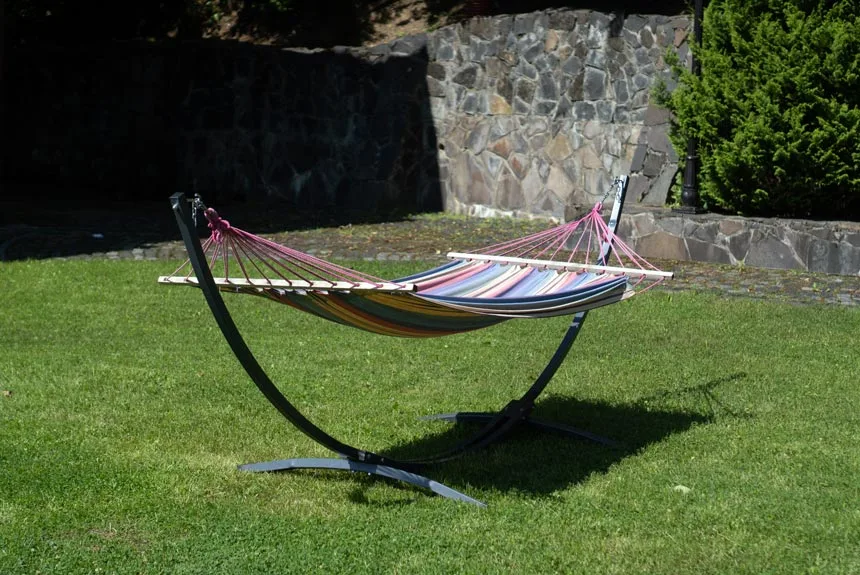Nothing is more important than enjoying a peaceful, relaxing time camping in the woods. One of the best ways to do this is to hang a hammock, allowing you to take a quick nap wherever you are. But what if there aren’t any trees nearby? Then how to hang a hammock without trees?
While it’s true that most hammocks are set up in areas with trees, it’s possible to hang them without trees. With suspension straps and carabiners, hammocking has now become easier. The only thing standing between you and your perfect hammock grove is a few hacks!
Therefore, this article will introduce some easy tricks and techniques for hanging hammocks without trees. So, let’s get started.
Table of Contents
Hammock Camping without Trees
You will find different ways to hang a hammock, but the most widely used methods to hang camping hammocks without trees are discussed below,
1. Get Tripod Hammock Stands

Building your own hammock stand is great if you have the right materials. It is an excellent additive to keep your hammock hanging without needing trees.
However, if you’re lucky enough to find a tree ideal for hammocks, your choices will become more flexible. You can string one end of the hammock rope with that tree and another with your created hammock stand.
To make the perfect DIY tripod hammock stand, you need three good-sized bamboo sticks that are the same length. Use the rope to tie the sticks together in a triangular shape and secure it with thick twine.
To start, get three 8 feet long branches 3 – 4 inches in diameter. You need to make seven poles from these three branches: three for the base, one for each side, and the top.
Place your three wooden legs in a row. Tie them together with an anti-slip rope, and once you have enough slack, spread them apart evenly to accommodate your hammock length. For the second stand, you need to follow the same techniques.
In conclusion, get a rod and put it on top of the sturdy posts so that it stays connected and doesn’t fall back when you enjoy hammocking on a comfy night.
2. Get Some Rocks
Rock anchors are considered one of the oldest hammock ideas without trees. It won’t give you much hassle as it is relatively quick and easy to hang a hammock off of rocks.
While pitching your hammock on rocks, ensure you keep the rocks at a minimum ideal distance of 10 to 18 feet apart. Also, decide to set anchors on large rocks. That way, they will have enough balance to support your body weight.
Rock hammocks are a fun and challenging camping choice, but you’ll need to set up your hammock carefully. This is particularly true if you’re not near trees or on level ground — in these cases, you have to depend on boulders or other uneven structures for support.
3. Have Car Anchors
In addition to trees, cars, motorcycles, and other vehicles can also serve as anchors to hang up your hammocks. And it’s better to find suitable trees to hang one side of the hammock while the other end of your hammock gets hung from your vehicle.
It is vital to use a roof rack and tie-down straps designed for camping gear or kayaks for the best results. These have been tested to support heavier loads than their standard counterparts.
Attach your hammock to the roof rack and secure it using ropes to a secondary anchor point. This setup can be used for an afternoon nap or an outdoor getaway for the night!
Although it’s not advisable to regularly use a car as a hammock stand, it might save the day when you need it most.
4. Use Old Tent Poles
If you’re an avid camper, chances are you have a few tent poles and pegs in storage. Why not repurpose these items for hammocks?
Tent poles are perfect for holding up hammocks. It stabilizes the hammock so well that you will not fear tears and wear during hammocking.
Fast post anchors are a great way to hold up the hammocks, and sturdy hooks provide an easy way to attach the hammocks to the anchors for secure hanging.
5. Rely on Building Structures

When camping in an urban area, you can use walls, bridges, trees, and other outdoor structures to hang hammocks.
The best option is to go with a pavilion found at national or state parks. Pavilions are large tents resembling bandstands, providing shade for all who seek it. They often come with a long rope attached to a center beam that you can use as hammock posts.
While this is an easy method of hanging your hammock, you must always take safety precautions in case the hammock falls off the building. To ensure a safe hammock, you must use solid hooks and screws to attach it to the structure.
6. Look For Hammock Structures
Check to see if the campsites offer pre-existing hammock structures before booking. Most camps don’t have any hammock structures, but this isn’t always the case. Spending an extra $5 to $15 per night on a campsite with hammock platforms can save you a lot of headaches during your trip.
Since hammocks are entirely portable, they may be attached to any structure. Permanent structures can accommodate fixed hammocks, but portable ones can be tied to trees or other sturdy fixtures. Some parks may even have hammock stands that resemble posts, allowing you to connect your hammock wherever you want.
Using a portable hammock stand is not a requirement at every campsite, but it can be beneficial to have one on hand. The stands are designed to help you create a comfortable spot in the woods when there is no natural tree available, and they’re usually easy to carry and simple to set up.
7. Check For Fencing, Posts, and Poles

For setting up your hammock, you can use any sturdy fixture. Fence posts, trees, and poles around your campsite are examples of this.
You must, however, be cautious when using your hammock. Just because it is made for camping doesn’t mean that campgrounds can support it. Before attaching any campsite fixtures to your hammock tent, talk to the campsite manager.
While at a campsite, you should do what you can to leave it better than you found it. If you must change the campground to enjoy your hammock, resist the urge to modify anything. It’s probably best to find another place to hang your hammock.
The Bottom Line
There are many reasons to appreciate a hammock when planning a camping trip with friends or to rest in your back garden. It allows you to hang out and be comfortable resting anywhere you want.
If you’re looking to get a hammock but don’t have trees available, here are some tips on hanging a hammock without trees. In the comment section below, you can also suggest other ways you would like to know.
All the suggestions above are fairly inexpensive, don’t require any specialized gear, and are relatively easy to implement. Meanwhile, they provide comfortable, low-maintenance sleeping spaces that you can enjoy for years.




